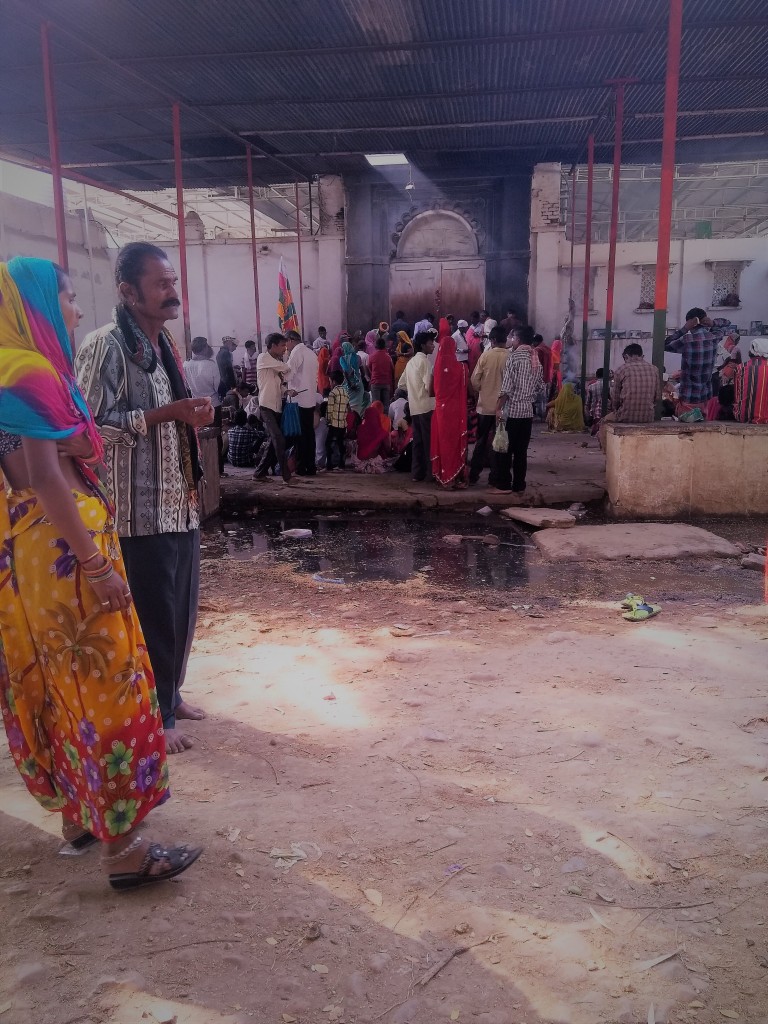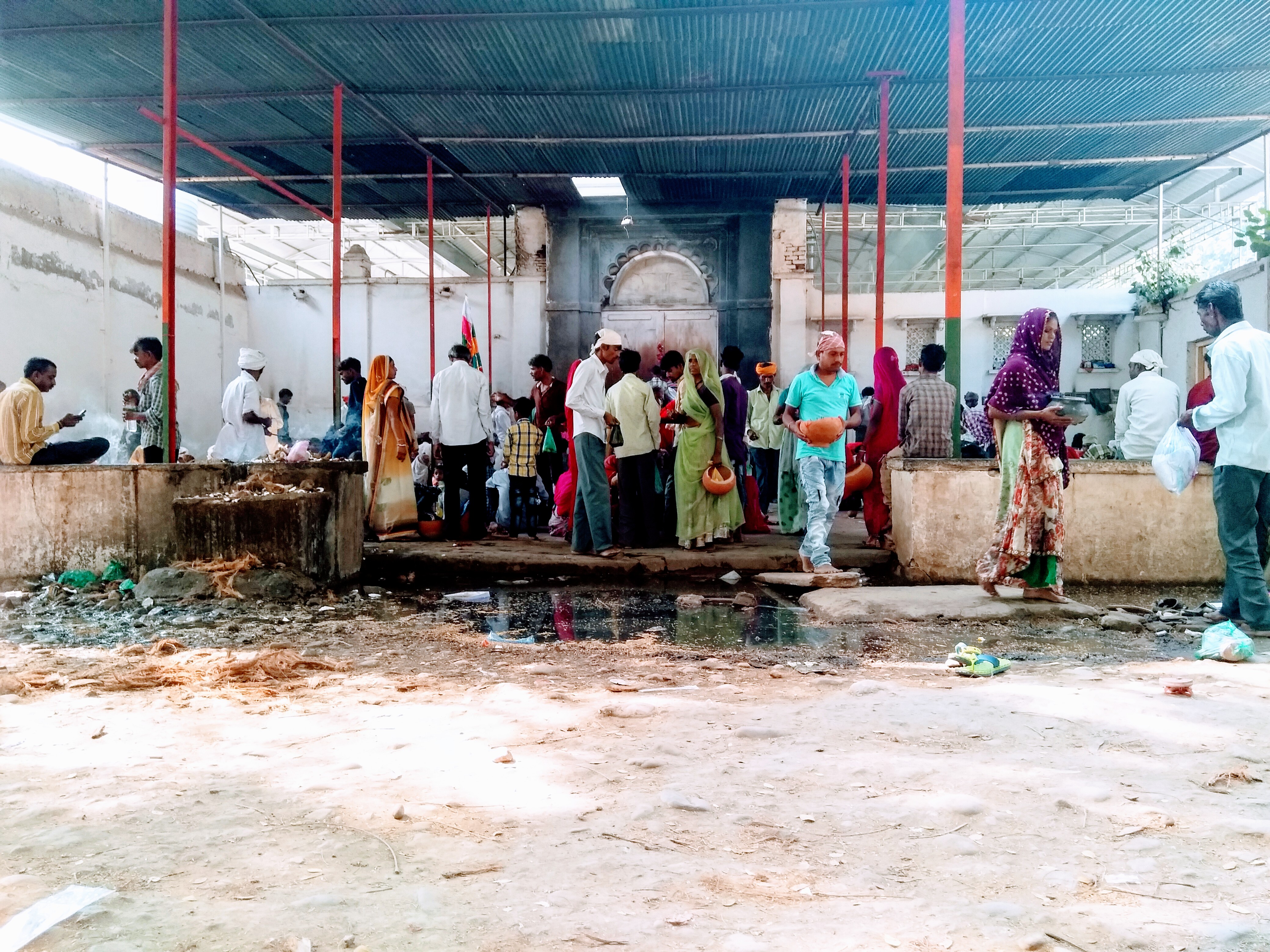Mazar-e-Fakhri , a renowned Dargah of an Islamic Saint Syedi Fakhruddin Shaheed located in the center of the small town of Galiyakot sees hundreds of tourists and pilgrims arriving to pay their reverence. Picturesque white domes flanked by lush green manicured garden make this religious shrine stand out from the sub-minimal look of the semi-urban town of Galiyakot. Located in the cusp of the three states – Rajasthan , Madhya Pradesh and Gujarat, this quaint town is surrounded by a stretch of tribal villages and is connected with the slight better-off cities of Dungarpur and Banswara.

The lanes leading to Mazar-e-Fakhri coincide with a yet narrower muddy lane where a flock of men in dhotis and veiled women in red and pink ghagras is seen proceeding towards the backyard of the Dargah. Every once in a while a rickety bus and an overcrowded jeep halt and an assortment of women and men proceed towards the backyard of the Dargah. An overwhelming waft of incense, camphor, lemons nauseate the senses along with sounds of wails, screams from a corner. In the backyard of the premises, as though an anti-thesis of the spiritual semblance that the dargah holds, one comes across frantic practices of exorcism practiced upon ailing and frail women, severely ill men choking and coughing profusely and occasionally two or three persons of mental illness.
The Southern fringe of Rajasthan is a tribal-dominated area comprising of some of the remotest areas occupied by Meenas, Bhils, Gametis and Garasiyas stretched across these remote, inaccessible spaces. The entire tribal belt is far from the touch of development initiatives, where literacy levels are as low as 26- 38% and PHCs are as far as 25-30 kilometers away and almost every family falls Below Poverty Line. Being a prominent corridor that sees 55-60% of distress migration, the landscape is marred with morbidities and mortalities caused by Tuberculosis that pervade the existence, productivity, and health of the family. Coupled with poor care-seeking, non-availability of effective health systems have rendered practices of traditional healers as care-providers more pronounced and interspersed with stigmas and superstitions.
The Dargah also infamously known in the tribal hamlets as ‘pir baba bawsi’ or ‘TB Mandir’ is the first point of care for many patients of Tuberculosis.
“It is all in Pir Baba’s hands. No pill or injection, this is the evil game of spirits that possess the body,” Raana *, a traditional healer (also called bhopa) explains as he ushers in a group of men and women. A highly stigmatized illness, its symptoms of persistent cough, chest pain, intermittent fever are equated with demon’s possession that can be expelled through a series of incantation, trances, and with the practice of ‘daam‘. A block of heated iron wrapped in cloth is heated and pressed on the chest “to remove the pain haunting the chest in the form of daam“, as Raana explains. “There are patients who give up on pills and live here till they are cured. Pills have never done any good after all”. 41-year old Raana hails from a small village 50 kms from Galiyakot. Every week he visits the Dargah twice a week accompanying a group of patients -“patients of the coughing problem and breathlessness, women who are not conceiving and those whose mind does not work. These are possessed souls by the evil who are freed by us. Everyone in the village knows me. My ancestors have been bhopas serving the community mata mandir for years now. Whenever anyone falls sick, we first perform ‘jhaadaa-jhaptaa’ in the house and then send them to Galiyakot.”

A 2005 Study called ‘Health Care Delivery in Rural Rajasthan’ (Banerjee, Deaton, Duflo) conducted in the rural areas of the adjacent district of Udaipur revealed on an average 45% of public health facilities saw absenteeism of medical staff. The Study also highlights how communities in the vicinity of oft-shut facilities saw a higher dependence on traditional healers for seeking care. A clear nexus and coordination between the local bhopas of these hamlets and the local bhopas of the Galiyakot transpire in which families are sent received and go through a series of exorcist practices that spread across four to ten Fridays.
Like Raana, I meet Bhairav * , a bhopa from Galiyakot who helps me navigate through a pool of women with open hair , in semi-conscious, fatigued condition screaming as soon as a stroke of peacock feather is swiped on their face. A few years younger than Raana, Bhairav shares that he had his parents had passed away when he was barely 11 years old. He was adopted by a Bhopa who served in the dargah. “When I was around fourteen years old, I had gone to the marble mines to work. It was one of those times where I had fallen down and I was brought to Baba. I was cured in a span of seven jhummas.” I barely get to interact with Bhairav as he spots a family of three and guide them to the backyard and enquire the matter.
The backyard that defines the ‘pir bawsi’ is an open shed with one side facing the wall and the backdoor of the Mazar-e-Fakhri. Camphors, Vermillion, lemons, incense are profusely offered on the doorstep of the locked door. Every once in a while a woman in a frenzied trance and open hair is seen twirling her head and screaming through episodes of frantic incantations spelled by the Bhopa. In the meanwhile, all around men and women huddled together around a bhopa and his accomplice hum chants while awaiting their turn. After the episode of the trance, the possessed is taken to a nearby dried tree where a red yarn is spun around and tied to a nail hammered into the trunk. The existence of this living but dead tree-trunk hammered with nails and painted with a smack of vermillion and black ash depict an uncanny picture of the space. A stretch of drainage water and remains of the offerings clog the paths and serve as breeding grounds for flies and mosquitoes. A few meters away, a dilapidated room with verandah houses half-clad men lying on the floor, profusely coughing and in a dismal state. 57-year-old Kesha Ba was detected with tuberculosis and had returned back home henceforth. Through word-of-mouth, he had learned of the Pir bawsi mandir and had arrived here. Initially, he would visit every fortnight and then he moved in to stay at the dargah. With no affordable or accessible Guest houses or restrooms for him, Ba Saa would spend nights at the side of the gully or in one of those dilapidated houses. When his health deteriorated further he was taken to Sagwada the nearest town (30 km away) where he was further referred to Dungarpur and detected with drug-resistant Tuberculosis.

As I navigate through this space, a woman pulls me aside. “You do not seem to belong to this place. Why have you come here?” Absolutely taken aback I explain to her how I had heard much about this place that I wished to visit here. Clad in a cotton saree, Shanta a home-maker from a nearby village explains how she diligently visits this place every Friday after her husband leaves for office and children to school. She explains how ‘baba’ saved her husband from an intense family feud that “was the work of sinister witchcraft”. She goes on to share how evil spirits create rifts in relationships, in one’s mind. She points me to an 18-year-old girl – “she cannot speak any language except blabbering occasionally. People say she cannot understand directions as well. Pir baba has been merciful to the girl. She is brought to the dargah every day.” Shanta, however, goes on to say that her family believes in medicines and diseases cannot be cured with incantations.
The concept of exorcism intermixed with faith-healing for fatal illnesses crosscuts boundaries of cultures and histories, in which a strand of the religious belief assigns point persons as channels of communication between the spiritual powers. The tribal religious practices in these areas have seen a gradual absorption into Shaivite and Shakti cults of mainstream Hinduism. However here lies farther assimilation of an Islamic faith interspersed with tribal indoctrination of the Shakti cult and thus practices of Exorcism being an ensemble of many faiths. Popular belief has always seen Faith –healing and practices of exorcism as archaic and more staunch in remote rural areas where stigmas associated with certain illnesses like measles , tuberculosis, pneumonia , infertility, and predominantly mental illnesses are widely prevalent.

The recent generation however has had a mixed acceptance of such faiths. 27-year-old Bhesa* awaiting his brother’s turn at the Pir Bawsi leans on his bike parked aside and shares, “my brother has been suffering from joint pain for five months now. I do not prefer him coming here but as a younger brother I do have to serve him.” Another medical practitioner from Dungarpur shares,” people from my village still go…no, not my caste but the lower ones. They do not understand Science”. Amidst this defensive projection of the personal opinion as distanced from the community’s perspective, stronger stands have been taken at times as well. A vocal youth from his tribal community, Mohanlal* shares, “it’s an absolute waste of money and waste of one’s own life!” He goes on to share how his friend, who was diagnosed with TB had persuaded him to accompany to the pir bawsi. “He had lost all his income, he could not work. He borrowed some Rs 7000 and decided to visit Pir bawsi. Once he asked me to accompany him as he was too sick to travel alone. That’s when I saw him paying Rs 2500 to the bhopa. I was astounded! That night I took a decision for the entire family- he was not going back again”
Within the cosmos of a publicly churned health system aimed at Universal Health Coverage, belief systems strong enough to motivate the poor to travel far, live in drudgery with absolute faith and incur humongous out-of-pocket expenditure is an irony. And yet it exists with its ability to bring together religious beliefs under one definition that defies Science, medicine and establishes the thesis and its antithesis: the positive and the evil.
*Names of persons changed to preserve identity
By Manisha Dutta

